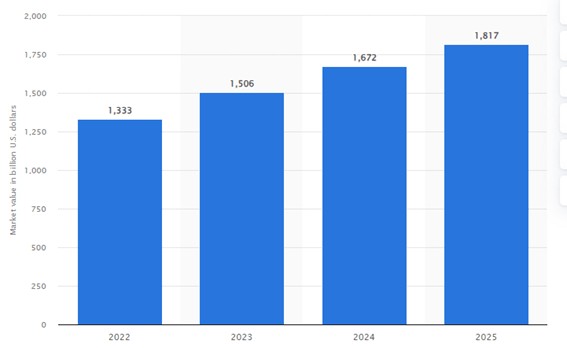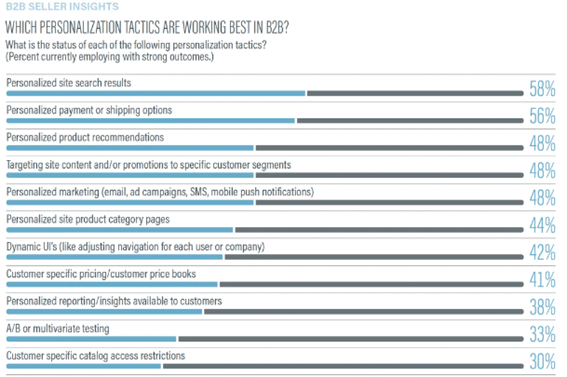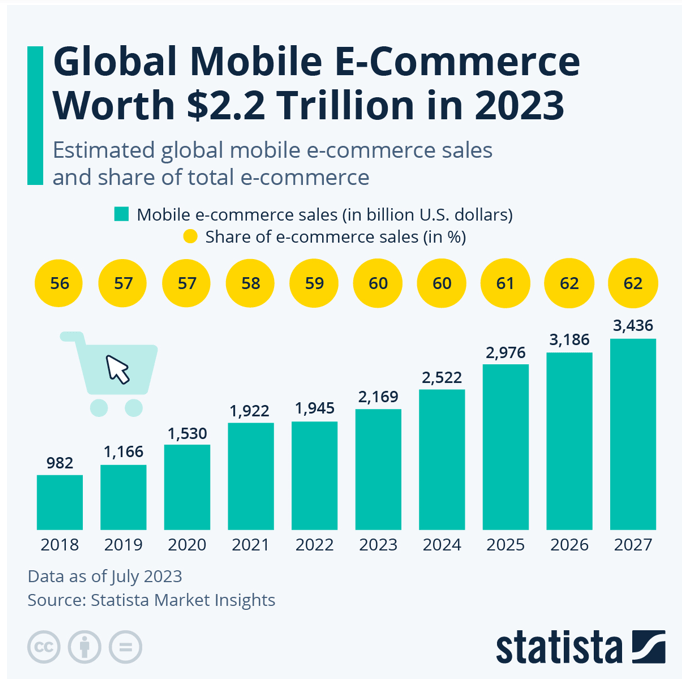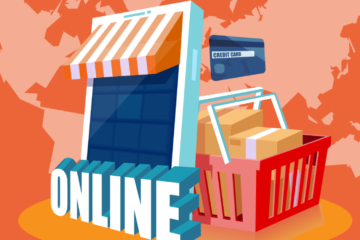
As we advance towards 2024, the landscape of B2B e-commerce is undergoing rapid transformation, driven by technological advancements and evolving market dynamics. According to Statista, the B2B e-commerce Gross Merchandise Value (GMV) in Europe is expected to exceed 1,672 billions U.S. dollars in 2024. This article explores the key trends poised to shape the B2B e-commerce sector in the upcoming year, offering valuable insights to help businesses adapt and thrive in this changing environment.

Embracing the Digital Shift
As digital technologies continue to advance, the B2B e-commerce landscape is experiencing a significant shift. Businesses must adapt to these changes by incorporating new technologies and strategies to remain competitive and meet evolving customer needs.
Hyperpersonalization:
Hyperpersonalization will become more prevalent in B2B e-commerce, with businesses leveraging data analytics and customer insights to provide tailored experiences. This approach will help companies meet specific client needs more accurately, enhancing customer satisfaction and loyalty.
According to Adobe, in 2023, 63% of B2B e-commerce companies invested in improving the user experience through new personalization features. However, 40% of small businesses identify personalization as a major challenge.
What personalization tactics do B2B companies find most effective?

The Rise of AI and Machine Learning:
AI and machine learning are set to play a pivotal role in transforming B2B e-commerce. According to Capgemini, 73% of consumers globally express trust in content generated by AI, highlighting the growing confidence in AI-driven solutions.
As stated by Statista, the market size in the Artificial Intelligence sector is projected to reach US$305.90 billion in 2024, with the United States leading globally with an expected market size of US$106.50 billion in the same year.
Talking about Machine Learning, which is also very important, DemandSage states that 48% of businesses globally are utilizing machine learning as of 2024, with the market size of machine learning forecasted to reach a value of $204.30 billion by the same year.

These technologies will drive smarter, more efficient operations, from predictive analytics to automated customer service, helping businesses stay ahead in a rapidly changing market.
Mobile and Voice-Activated Commerce:
Optimizing for mobile commerce is essential as B2B transactions increasingly shift to mobile devices. Additionally, voice-activated commerce is emerging as a critical trend, requiring businesses to adapt their platforms for voice search and commands.
According to Statista, Mobile e-commerce sales hit $2.2 trillion in 2023, accounting for 60 percent of total global e-commerce sales. These sales are projected to continue their global growth in 2024 ($2.522 trillion) and, in 2027, analysts at Statista anticipate these sales to reach $3.4 trillion.

Augmented Reality in Customer Experience:
Augmented reality (AR) is reshaping customer interactions in B2B e-commerce. AR technologies offer immersive and interactive experiences, crucial for understanding complex products and services in the telecom sector.
Payment Innovations and Data Utilization
According to ‘Supply Chain Channel’, the B2B payments market is on an upward trajectory in 2024, with a forecasted compound annual growth rate (CAGR) of 10% extending through to 2030. This growth is expected to elevate the global B2B payments market to a worth of $2.1 trillion. Furthermore, by 2025, the majority of B2B transactions are anticipated to be digital.
Innovations in payment methods and the strategic use of real-time data are becoming critical components in the B2B e-commerce sector. These elements are key to enhancing transactional efficiency and gaining actionable insights.
Flexible B2B Payment Solutions:
Adapting to various payment methods and offering flexible solutions will be essential in 2024. Businesses must meet diverse payment preferences to enhance the purchasing experience.
The Critical Role of Real-Time Data:
Real-time data utilization will be a decisive factor in B2B e-commerce. Access to up-to-date information will enable businesses to make informed decisions, optimize inventory management, and tailor marketing strategies to current market conditions.
Sustainability and Cooperative Commerce
Sustainability and cooperative commerce are becoming increasingly influential in shaping the future of B2B e-commerce. These trends reflect a growing emphasis on environmental responsibility and the benefits of collaboration in the digital marketplace.
Sustainability as a Priority:
Sustainability is emerging as a key consideration in B2B e-commerce. Businesses are integrating environmentally friendly practices in their operations, signaling a commitment to minimizing their environmental impact.
The Emergence of Cooperative Commerce:
Cooperative commerce is gaining traction, characterized by partnerships and integrations between various platforms and services. This approach highlights the importance of collaboration in providing comprehensive solutions to customers.
As businesses approach 2024, adapting to the emerging trends in B2B e-commerce is critical for staying competitive and relevant. Embracing technologies like AI, AR, and focusing on hyperpersonalization, sustainability, and cooperative commerce will be key to navigating the evolving e-commerce landscape. These strategies will not only enhance customer experiences but also drive operational efficiency and business growth.









